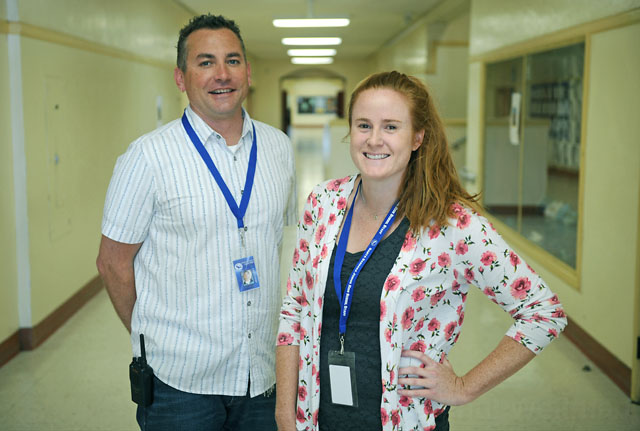
As students wearing the unofficial school uniform of skinny jeans and Vans skate shoes filed into Aaron Harkey’s Santa Barbara Junior High School classroom on Tuesday morning, he stood before his door greeting every single one with a handshake. Long before “restorative justice” made its way into the educational lexicon, and even longer before school districts adopted the less punitive-sounding if less descriptive term “restorative approaches,” Harkey knew there was something wrong with the way learning institutions treat children.
His conviction was born of his early years at the junior high school when he had difficult classes filled with students who circulated through a never-ending cycle of crime and punishment. “After my first year here, I realized that me writing office referrals and students going elsewhere isn’t working,” said the AVID teacher and response-to-intervention leader who is largely in charge of implementing a Restorative Approaches pilot program. Harkey, who majored in philosophy as a college student, said that restorative justice also spoke to his personal reflections on moral and ethical philosophy, the central question of which is, how should we treat each other and why?
When he traveled to Denver last May with a contingent of teachers and officials from Santa Barbara to observe the Restorative Approaches program in the public schools there, he said, “I thought, ‘Oh, this is what I’ve been trying to do.’” A brochure from Denver Public Schools explains that “Restorative Approach is a philosophy that fosters community healing and reparation.” It asks that students address their wrongdoing in a way that includes them as part of the school community rather than ostracizing them. And it requires teachers to address the root causes of misbehavior by asking questions such as, What happened? What role did you play? Who is responsible for making things right? and How will the harm be repaired?
SBJHS science teacher Cailean Kilroy explained, “I get to talk to kids one-on-one and hear about their home life.”
That simple kind of engagement with children goes a long way to building relationships and helping teachers get to know their students better. SBJHS science teacher Cailean Kilroy explained, “I get to talk to kids one-on-one and hear about their home life.” She said that just the other day, she took a student outside of her classroom for a conversation and the girl told her, quite honestly, “My parents were fighting last night, and I’m taking it out on you.”
“Restorative Justice,” said Kilroy, “is more about getting to the root of the problem than giving a punishment.” But it does not abolish punishment. There are still offenses that merit automatic suspensions, but when there is a choice, Harkey said, the school tries to avoid suspensions. Figuring out how students can repair the harm they’ve done takes creativity on the part of both students and teachers. Such decisions are arrived at through pre-conferences, conferences, and follow-ups. It definitely requires an investment of time on the front end for teachers, admitted Harkey — whose mediations have included making girls who would not normally associate eat lunch together — but he said that if done right, a restorative approach saves time in the long run. And, if all goes according to plan, students will eventually be able to hold conferences on their own without adult supervision.
The challenges to a restorative model, however, are manifest. For one, it has an image problem. When SBJHS Principal Lito Garcia reported to the school board on Tuesday night, Trustee Gayle Eidelson said some of her peers have called restorative justice “soft,” an attitude Harkey said some teachers also had initially. And a junior high school is the ideal setting to introduce a major shift in policy, both because of the age of the students and the fact that half of them are new. It will be much more difficult to implement restorative approaches at Santa Barbara High School next year — along with the other junior highs — where many students are inured to punitive discipline, some are further entrenched in unhealthy lifestyles, and the staff and student body are simply larger and more diffuse.
Still, said Garcia, he is a believer who had his come-to-Jesus moment on the Denver trip when he met three students who had been in a restorative conference earlier the same day. “To see them sitting on the couch joking around with each other, joking about their mistakes — right there I was sold.”
As of January 25 this year, SBJHS has had 18 suspensions as opposed to 46 at the same point last year. The number of students involved in multiple incidents is also down. Whether students are behaving better, administrators are exercising more restraint, or some combination of the two, the change is undeniable. And overdue, said Harkey. “The paradigm for education has not changed for generations. And everything else has changed.”



